|
|
|
Sort Order |
|
|
|
Items / Page
|
|
|
|
|
|
|
| Srl | Item |
| 1 |
ID:
137717
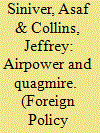

|
|
|
|
|
| Summary/Abstract |
This paper assesses the role that analogical reasoning played in Israel's decision making during the 2006 Second Lebanon War with Hezbollah. Two analogies seemed to dominate internal deliberations: the “air power superiority” analogy which drew on more than a decade of developments in military theory and the air-based campaigns of the two Gulf wars and the Balkan wars of the mid-1990s and late 1990s; and the “Lebanese quagmire” analogy which drew on Israel's own traumatic experience of Israel following the its first war in Lebanon in 1982. The misuse of these analogies by the Israeli political–military leadership during the war produced a myopic approach which advocated an almost total reliance on air power rather than ground maneuver to win the war and refrained from using ground forces for fear of entering another bloody and unpopular war in Lebanon. The constraining power of these analogies prevented the consideration of alternative courses of action or the effective calculation of cost-benefit analysis during the war. Whereas previous studies of the war provided various explanations to singular decisions or episodes, this paper shows that the air power and quagmire analogies contained the conceptual boundaries of Israeli decision making during the war and thus best explain its attraction and limitations.
|
|
|
|
|
|
|
|
|
|
|
|
|
|
|
|
| 2 |
ID:
133127
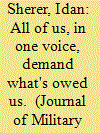

|
|
|
|
|
| Publication |
2014.
|
| Summary/Abstract |
This article examines the main characteristics of mutinies in the Spanish tercios at the height of the Italian Wars (1494-1559), a surprisingly under-researched subject considering the high frequency of such upheavals in these core infantry units. Contrary to the severe legal and moral implications of modern military mutinies the dynamics of the mutinies in the tercios resembled more closely those of a modern workers' strike, in that the soldiers were allowed room to organize, make representations, negotiate and reach relatively amicable conclusions. Generals and soldiers alike accepted the recurring mutinies as a way of maintaining the organizational status quo in a context of infrequent paydays and persistent supply problems.
|
|
|
|
|
|
|
|
|
|
|
|
|
|
|
|
| 3 |
ID:
133874
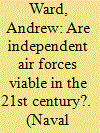

|
|
|
|
|
| Publication |
2014.
|
| Summary/Abstract |
Which modern operations becoming increasingly joint in their nature and airpower now in intrinsic part of every military operation, the need for independent air forces is questioned with special emphasis on the British case
|
|
|
|
|
|
|
|
|
|
|
|
|
|
|
|
| 4 |
ID:
133711
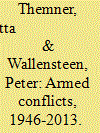

|
|
|
|
|
| Publication |
2014.
|
| Summary/Abstract |
In 2013, the Uppsala Conflict Data Program (UCDP) recorded 33 armed conflicts with a minimum of 25 battle-related deaths, up by one from 2012. Seven of these were recorded as wars, that is conflicts leading to 1,000 or more battle-related deaths in a calendar year. There have been 144 armed conflicts (47 wars) since 1989 and 254 armed conflicts (114 wars) since 1946. For the past ten years the amount of active armed conflict has fluctuated between 31 and 37. Six peace agreements were signed during the year 2013, two more than in the previous year. For the first time, this article also provides data on trends in battle-related deaths since 1989. These data do not show a clear time-trend. However, there is a particular difficulty in mapping the conflict in Syria, for which no credible battle-related deaths in 2013 can yet be reported.
|
|
|
|
|
|
|
|
|
|
|
|
|
|
|
|
| 5 |
ID:
133804
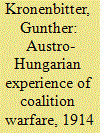

|
|
|
|
|
| Publication |
2014.
|
| Summary/Abstract |
Austria-Hungary's experience of Germany's junior partner was fraught with misunderstandings and a failure to devise a coherent common strategy
While the Anglo-French experience of coalition warfare during the First World War has been the subject of many English-language volumes, Austria-Hungary's relationship with Germany - its senior partner within the Triple Alliance - has been underexplored. In this article, Günther Kronenbitter analyses the uneasy dynamics of this alliance, tracing it through the two countries' wilfully blinkered, thirty-year preparations for a war that eventually came in August 1914, before exploring their increasingly fraught and inadequate efforts to co-ordinate their campaigns and resources - a process marked by resentment and, more importantly, a failure to take a unified strategic approach.
|
|
|
|
|
|
|
|
|
|
|
|
|
|
|
|
| 6 |
ID:
133061
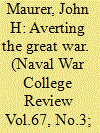

|
|
|
|
|
| Publication |
2014.
|
| Summary/Abstract |
Winston Churchill is best remembered as a valiant leader in times of war. He should also be remembered, however, for his efforts to prevent the catastrophic great wars that would scar the history of the twentieth century. While it is largely forgotten today, on the eve of the First World War Churchill made a remarkable attempt to halt the head-to-head competition in naval armaments that was setting Great Britain and Germany against one another as adversaries. In a bold and unconventional initiative, Churchill invited Germany's rulers to take a "holiday" from the competitive building of battleships. As the civilian head of Britain's Royal Navy, Churchill made public appeals for a naval holiday on three separate occasions before 1914. Behind the scenes too he pressed for the opening of negotiations with Germany, using the holiday proposal as the starting point for discussions. It was Churchill's earnest hope that the naval holiday would stop the action-reaction dynamic of the arms race-what statesmen of that era called "the sea war waged in the dockyards"-and reduce the antagonism between Britain and Germany. Rather than letting Britain and Germany be arrayed in opposing camps, he wanted to promote cooperation between Europe's two leading great powers.
|
|
|
|
|
|
|
|
|
|
|
|
|
|
|
|
| 7 |
ID:
139181
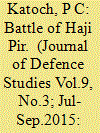

|
|
|
|
|
| Summary/Abstract |
In 1965, Pakistan attempted infiltration into Jammu and Kashmir (J&K), with Operation Gibralter, followed by a planned capture of Akhnoor Bridge under Operation Grand Slam. While Operation Gibraltar was bold from the point of view of multi-directional infiltration, it was largely based on the utopian dream of President Ayub Khan and Foreign Minister Zulfiqar Ali Bhutto, ignoring the ground realities that J&K’s population would not support it. The Indian reaction was swift and included the epic capture of the strategic Haji Pir Pass at a height of 2,637 metres (m) on the formidable Pir Panjal Range that divided the Srinagar valley from the Jammu region. The pass has been a constant source of problems since Pakistan-trained militants have been sneaking into the Kashmir Valley, Poonch and Rajouri districts. Ironically, the Haji Pir Pass, captured through a heroic and daring action, had to be returned to Pakistan under the Tashkent Agreement.
|
|
|
|
|
|
|
|
|
|
|
|
|
|
|
|
| 8 |
ID:
131518
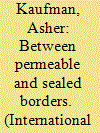

|
|
|
|
|
| Publication |
2014.
|
| Summary/Abstract |
The Trans-Arabian Pipeline (Tapline), which extended from Dhahran in Saudi Arabia to Zahrani in Lebanon and operated from 1950 to 1982, was haunted by the Arab-Israeli conflict throughout the years of its operation. The route of the pipeline-which traversed Saudi Arabia, Jordan, Syria, and Lebanon-was chosen so as to circumvent Palestine/Israel. However, following the Israeli occupation of the Golan Heights in the 1967 war, Israel became an active participant in this project, with the full consent of the transit states and Egypt. This article uses Tapline as a means to analyze the interconnected world facilitated by oil pipelines, which defies common wisdom about state sovereignty or the function of interstate boundaries. In addition, Tapline demonstrates how this interconnected network created possibilities for Arab-Israeli cooperation that might have seemed inconceivable initially, given the hostile dynamics of the conflict.
|
|
|
|
|
|
|
|
|
|
|
|
|
|
|
|
| 9 |
ID:
128951
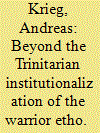

|
|
|
|
|
| Publication |
2014.
|
| Summary/Abstract |
Traditionally in liberal normative theory the warrior's ethos has been defined on basis of the warrior's raison d'être as the trinitarian protector of the social contractarian discretionary association of society and state. Since the post-modern warrior, whether serving in state uniform or as an employee of a commercial enterprise, is increasingly asked to provide security as a global rather than public good on the liberal state's behalf in non-trinitarian contingency operations, this paper provides a broader normative conceptualization of the post-modern warrior ethos. Trinitarian operations in this respect are defined as those operations that revolve around the state soldier's primary trinitarian function of providing security for society and state as a member of the Clausewitzian trinity of society, state and soldier. Instead of solely conceptualizing the warrior's ethos as a narrow trinitarian institutionalization process, this paper demonstrates that for the warrior who provides security increasingly in non-trinitarian operations, the post-modern warrior ethos becomes more and more an alternatively institutionalized characteristic of spirit beyond the social contractarian trinity. Shaping both the soldier's and the contractor's commitment in non-trinitarian contingency operations, the alternative non-trinitarian institutionalization of the warrior's ethos ensures that the post-modern warrior remains a virtuous and committed security service provider amid high operational risks even when serving the interests of common humanity rather than of his family, state and nation.
|
|
|
|
|
|
|
|
|
|
|
|
|
|
|
|
| 10 |
ID:
134198
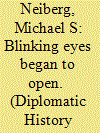

|
|
|
|
|
| Publication |
2014.
|
| Summary/Abstract |
This article examines American reactions to the First World War from 1914 to American belligerence in 1917. Despite Woodrow Wilson's plea for Americans to be neutral, they had strong reactions to the war. These reactions led to three important legacies in America's dealings with the rest of the world.
|
|
|
|
|
|
|
|
|
|
|
|
|
|
|
|
| 11 |
ID:
133799
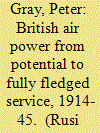

|
|
|
|
|
| Publication |
2014.
|
| Summary/Abstract |
The First World War set British air power on a path of development that by 1939 made an essential contribution to the conduct of war
At the start of the First World War, the potential of air power for military purposes had already been identified but remained largely underdeveloped, with Britain lagging behind some of its direct European competitors. Peter Gray traces how the First World War acted as a catalyst for British forces to use air power in attack and reconnaissance roles, and unleashed the potential for its further development during the interwar years. By the Second World War, air power had become an indispensable element of warfare.
|
|
|
|
|
|
|
|
|
|
|
|
|
|
|
|
| 12 |
ID:
133798
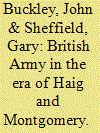

|
|
|
|
|
| Publication |
2014.
|
| Summary/Abstract |
Negative myths about the British Army's performance, especially during the Great War, obscure the reality of an institution that learned and improvide throughout both world wars
The performance of the British Army in the two world wars has been the subject of much scrutiny in both scholarly and popular history. The latter has long been dominated by the perception of an underperforming army fighting under incompetent leadership in a futile First World War, in contrast to a more successful and effective force supporting a just cause in the Second. Yet, John Buckley and Gary Sheffield argue, sound scholarly research paints a much more nuanced picture of an institution that between 1914 and 1945 underwent a rich learning process that must be understood in its entirety.
|
|
|
|
|
|
|
|
|
|
|
|
|
|
|
|
| 13 |
ID:
133800
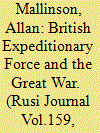

|
|
|
|
|
| Publication |
2014.
|
| Summary/Abstract |
A counterfactual account of what Britain's leaders could have done prior to the Great War to prepare the country more effectively for fighting a European land war
The decision-making of Britain's political and military leaders in August 1914 has been subject to much scrutiny in the intervening century. Allan Mallinson argues vehemently that the wrong decisions were taken in the years preceding the outbreak of the conflict, and presents a counterfactual of what Britain's experience could have been had conscription been introduced or sounder preparations for a land engagement been made before 1914.
|
|
|
|
|
|
|
|
|
|
|
|
|
|
|
|
| 14 |
ID:
132418
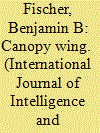

|
|
|
|
|
| Publication |
2014.
|
| Summary/Abstract |
Although Winston Churchill declared that history is always written by the victors, never the vanquished, a group of former East German foreign intelligence officers seem determined to prove him wrong. Calling themselves Insiders have been churning out books since the end of the Cold War that recount the history of that conflict from their perspective. The Insiders' mantra is that they were on the right, even if losing, side because they "spied for peace" to protect the Warsaw Pact against the existential threat posed by the "aggressive intentions" of the West.
|
|
|
|
|
|
|
|
|
|
|
|
|
|
|
|
| 15 |
ID:
132462
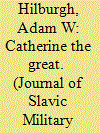

|
|
|
|
|
| Publication |
2014.
|
| Summary/Abstract |
The campaigns of Catherine the Great against the Ottoman Empire in the 1770s reveal key characteristics of operational art. Catherine's campaigns serve as an example of lesser-known conflicts that fulfill the necessary conditions of the numerous schools of thought on operational art. The operational commander, Rumiantsev, developed an operational plan to meet the strategic directives developed by Catherine's permanent 'Council attached to the Court'. His armies used successive tactical actions to engage Turkish maneuver forces and lay siege to its fortresses. The armies were organized into combined arms corps that coordinated to remain mutually supporting with the ability to concentrate at the decisive point when required and the Russian armies to not fight in the linear methods of its Western counterparts. Additionally, the armies and corps conducted distributed operations throughout the theater of war, at times hundreds of kilometers separating them. More importantly, Rumiantsev arranged tactical actions to achieve strategic objectives, the most important part of the definition of operational art. These successive, distributed operations should satisfy the schools of thought that consider Napoleon's campaigns as operational art, but those that understand operational art beginning with Grant and Moltke may see that the Russian Campaigns on the frontiers also move beyond the classical strategy of a single point
|
|
|
|
|
|
|
|
|
|
|
|
|
|
|
|
| 16 |
ID:
134003
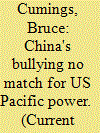

|
|
|
|
|
| Publication |
2014.
|
| Summary/Abstract |
Readers of a certain age will recall the cadences of the satirist Tom Lehrer's "National Brotherhood Week," and perhaps also his indelible punch line: "And everybody hates the Jews" (though fortunately that is not an East Asian problem). You may notice that my adaptation of the ditty leaves out the United States, which made war in East Asia from 1941 to 1975, and during those wars hated "the Japs," "Red China," Korean commies, and the Viet Cong. All such hatreds were nicely reciprocated by East Asians, and, by the 1980s, the Americans had even contrived to be hated by the South Koreans.
|
|
|
|
|
|
|
|
|
|
|
|
|
|
|
|
| 17 |
ID:
137183
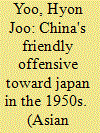

|
|
|
|
|
| Summary/Abstract |
This article explores why the People's Republic of China employed a surprisingly soft and lenient policy toward Japan in the 1950s despite their historical and political animosities. Relying on a relatively new concept in the study of international relations, I argue that China's conciliatory policy toward Japan represented a wedge strategy that was designed to detach Japan from the United States and weaken the US-Japan alliance. The logic of the theory also reveals that China's policy was in line with its “united front” against the United States during the Cold War.
|
|
|
|
|
|
|
|
|
|
|
|
|
|
|
|
| 18 |
ID:
134099
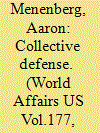

|
|
|
|
|
| Publication |
2014.
|
| Summary/Abstract |
Since the end of World War II, Japan has relied on the United States for its security, an arrangement enshrined in the US-written Japanese Constitution of 1947 and augmented by subsequent agreements between the two allies. Article IX of the Constitution prohibits Japan from taking part in any conflict or building a traditional military. (When President George H.?W. Bush organized the "coalition of the willing" against Iraq in 1991, Japan was able only to offer financial assistance because of this stipulation.) But with the rise of China and its assertion of sovereignty in regions Japan claims as its own, Tokyo has begun to expand its military capability. Some government officials wonder how these moves will affect relations with the United States, Japan's protector for the last half-century.
|
|
|
|
|
|
|
|
|
|
|
|
|
|
|
|
| 19 |
ID:
132411
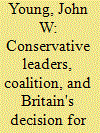

|
|
|
|
|
| Publication |
2014.
|
| Summary/Abstract |
Conservative leaders may have had a decisive impact on the decision by the Liberal government to enter the Great War in August 1914. In a seminal article of 1975, Keith Wilson argued that their readiness to fight "cut the ground … from beneath the feet of the non-interventionists" in the Cabinet. Those ministers who had hitherto opposed war now recognised that continued divisions could bring the government's collapse, in which case the Unionists, probably in a coalition with pro-war Liberals, would take office and enter the conflict anyway. Since Wilson's essay, important light has focussed on Unionist thinking by works that look at the July Crisis as part of a longer party history. This analysis provides a detailed investigation of the actions of Unionist leaders in the days immediately leading to war. It resolves some of the main contradictions in the primary evidence, argues that the possibility of a coalition was very real and demonstrates that one key player-the first lord of the Admiralty, Winston Churchill-subsequently tried, with some success, to disguise his activities.
|
|
|
|
|
|
|
|
|
|
|
|
|
|
|
|
| 20 |
ID:
133130
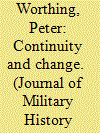

|
|
|
|
|
| Publication |
2014.
|
| Summary/Abstract |
This article analyzes the Chinese Nationalist Army at the tactical level, examining how the Nationalists deployed and employed forces to achieve victory from the earliest battles in 1925 to the first stage of the war against the Japanese in 1937-1938. It argues that certain "core characteristics" of the Nationalist Army shaped its tactics in a way that maximized its strengths and minimized its weaknesses, producing a number of important victories from 1925 to 1930. Importantly, the year 1930 marked a key turning point as new enemies and conditions led the Nationalists away from the successful tactics of the 1920s, contributing to the weaker record of the 1930s.'
|
|
|
|
|
|
|
|
|
|
|
|
|
|
|
|
|
|
|
|
|